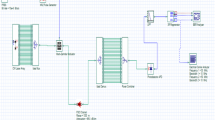Abstract
In this work the free space optics (FSO) and the millimeter waves (MMW) links are studied for the Uruguayan weather conditions. FSO availability is affected by fog significantly, while MMW availability is mainly affected by rains. Considering visibility and rain intensity data, these availabilities are estimated for the Uruguayan weather conditions. The results are extensible to other areas with similar weather. Finally the use of both links simultaneously, one as a backup of the other, is discussed.










Similar content being viewed by others
References
Kamalakis, T., Neokosimidis, I., Tsipouras, A., Sphicopoulos, T., Pantazis, S., & Andrikopoulos, I. (2007). Hybrid free space optical/ millimeter wave outdoor links for broadband wireless access networks. In Proceedings of the 18th annual IEEE international symposium on personal, indoor and mobile radio, communications (PIMRC’07).
Bloom, S., & Hartley, S. (2002). The last-mile solution: hybrid FSO radio. http://www.freespaceoptic.com/WhitePapers/Hybrid_FSO.pdf.
MRV. (2009). TereScope series brochure. http://www.mrv.com/library/docs/PDF300/MRV-PRODOVW-TereScope.pdf.
Korevaar, E. J., Kim, I. I., & McArthur, B. (2003). Atmospheric propagation characteristics of highest importance to commercial free space optics. In Proceedings SPIE 4976 (Vol. 1).
Hansryd, J., & Eriksson, P. (2009). High-speed mobile backhaul demonstrators. Ericsson Review, 2, 10–16. http://www.ericsson.com/ericsson/corpinfo/publications/review/2009_02/files/Backhaul.pdf.
Al Naboulsi, M., Sizun, H., & de Fornel F. (2005). Propagation of optical and infrared waves in the atmosphere. http://www.ursi.org/Proceedings/ProcGA05/pdf/F01P.7(01729).pdf.
Al Naboulsi, M., Sizun, H., & de Fornel, F. (2004). Fog attenuation prediction for optical and infrared waves. Optical Engineering, 43(02), 319–329.
Leitgeb, E., Muhammad, S. S., Flecker, B., Chlestil, C., Gebhart, M., & Javornik, T. (2006). The influence of dense fog on optical wireless systems, analysed by measurements in graz for improving the link-reliability. In Proceedings of international conference on transparent optical networks (vol. 3, pp. 154–159).
Fischer, K. W., Witiw, M. R., & Eisenberg, E. (2008). Optical attenuation in fog at a wavelength of 1.55 micrometers. Atmospheric Research, 87(3–4), 252–258. [Third international conference on Fog, Fog collection and Dew].
Zabidi, S. A., Al Khateeb, W., Islam, M. R., & Naji, A. W. (2011). Investigating of rain attenuation impact on free space optics propagation in tropical region. In Proceedings of the 4th international conference on mechatronics (ICOM) (pp. 1–6).
International Telecommunication Union Radiocommunication Sector, Attenuation due to clouds and fog, Recommendation ITU-R P.840-5, 2012.
International Telecommunication Union Radiocommunication Sector, Specific attenuation model for rain for use in prediction method, Recommendation ITU-R P.838-3, 2005.
Nadeem, F., Leitgeb, E., Koudelka, O., Javornic, T., & Kandus, G. (2008). Comparing the rain effects on hybrid network using optical wireless and GHz links. In Proceedings of 4th international conference on emerging technologies (ICET) (pp. 156–161).
International Telecommunication Union Radiocommunication Sector, Fixed service applications using free-space optical link. Report ITU-R F.2106-1, 2010.
Kim, I. I., McArthur, B., & Korevaar, E. J. (2001). Comparison of laser beam propagation at 785 nm and 1550 nm in fog and haze for optical wireless communications. In Proceedings of SPIE 4214 (pp. 2637).
Wetterzentrale, Worldwide Station List, http://www.wetterzentrale.de/klima/stnlst.html.
Kruse, P. W., McGlauchlin, L. D., & McQuistan, R. B. (1962). Elements of infrared technology: Generation, transmission, and detection. New York: Wiley.
Muhammad, S., Kohldorfer, P., & Leitgeb, E. (2005). Channel modeling for terrestrial free space optical links, transparent optical networks. In Proceedings of the 7th international conference (Vol. 1, pp. 407–410).
MRV. (2003). TereScope 3000 user’s manual. http://sup.xenya.si/sup/info/mrv/terescope/T3000%20User’s%20Manual%20Rev%205.pdf.
Rahim, S. K., Rahman, T. A., Tan, K. G., & Reza, A. W. (2012). Microwave signal attenuation over terrestrial link at 26 GHz in Malaysia. Wireless Personal Communications, 67(3), 647–664.
Mandeep, J. S., & Allnutt, J. E. (2007). Rain attenuation predictions at ku-band in south east Asia countries. Progress in Electromagnetics Research, 76, 65–74.
Acknowledgments
The authors’ thanks go to the Dirección Nacional de Meteorología for providing visibility and rainfall registers, and specially to Rodolfo Pedocchi and Mario Bidegain for their valuable cooperation.
Author information
Authors and Affiliations
Corresponding author
Rights and permissions
About this article
Cite this article
Barabino, N., Rodríguez, B. Performance Evaluation of FSO and MMW for the Uruguayan Weather Conditions. Wireless Pers Commun 73, 1077–1088 (2013). https://doi.org/10.1007/s11277-013-1249-y
Published:
Issue Date:
DOI: https://doi.org/10.1007/s11277-013-1249-y



